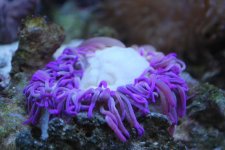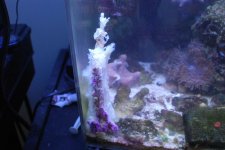You are using an out of date browser. It may not display this or other websites correctly.
You should upgrade or use an alternative browser.
You should upgrade or use an alternative browser.
Anemone Help Needed
- Thread starter knugenx
- Start date
- Location
- 11756
Karman, that looks like its a goner 
- Location
- The Big City
As Kris said, it's a goner. You should siphon it out of the tank before it messes the tank up.
- Location
- Jersey City NJ
I always wanted to know what causes these anenomes to die my anenome looked the same when he died but allmy water parameters were perfect
I always wanted to know what causes these anenomes to die my anenome looked the same when he died but allmy water parameters were perfect
I have no clue...was doing fine...last night...everything else is doing fine...gonna do some WC to clear up the water...
- Location
- East Stroudsburg, PA
Sorry for your loss of your anemone....:frown:
- Location
- lindenhurst,ny
yeah its a gonner
- Location
- New Jersey
Anemones
Hey,
Just an FYI, that anemone needed sand.
Some anemones live in sand or on rock.
Anemones are very hard to keep and if they dont have the right conditions they will stress out and die.
Most people make an impulse buy of them but, its actually the type of animal u want to check on for a couple days before you buy.
Hey,
Just an FYI, that anemone needed sand.
Some anemones live in sand or on rock.
Anemones are very hard to keep and if they dont have the right conditions they will stress out and die.
Most people make an impulse buy of them but, its actually the type of animal u want to check on for a couple days before you buy.
sorry for the loss bud. the first pic i would have said that it just crapped but the 2nd pic looks like it got bothered by something. usually anemones when they die clean they just get smaller until they die off small and flatten out and would look like it's fish food but your 2nd picture looks like it got attacked or maybe your powerhead got a hold of it and got sucked in and got shreded.
- Location
- New Jersey
Bogliman
The first pictures your anemones mouth is open, which is a sign of stress. Couple with the lack of sand the anemone began to stress out and their mouths open wider and wider.
In the 2nd pic i would have to contradict what bogliman said. Your anemone has began to breakdown and decompose. It looks like a typical dead anemone. The true way to tell if an anemone is dying is to smell it. ITS HORRID.
Your best bet is to stick with a bubble tip or make sure when your purchase a anemone that requires sand, that you place it on the sand bed so i can dig its foot in.
There is only two anemones that are know to split on their own. Bubble tips and Magnificas. No other anemones split.
The first pictures your anemones mouth is open, which is a sign of stress. Couple with the lack of sand the anemone began to stress out and their mouths open wider and wider.
In the 2nd pic i would have to contradict what bogliman said. Your anemone has began to breakdown and decompose. It looks like a typical dead anemone. The true way to tell if an anemone is dying is to smell it. ITS HORRID.
Your best bet is to stick with a bubble tip or make sure when your purchase a anemone that requires sand, that you place it on the sand bed so i can dig its foot in.
There is only two anemones that are know to split on their own. Bubble tips and Magnificas. No other anemones split.
- Location
- Forest Hills
As stated keeping anemone is not easy, some much harder than others, but there is no hope if getting one that's not healthy in the 1st place. So here's some tips to consider:
Choosing a healthy Anemone
Not my work folks, but I thought I'd place it here for for some of you that are looking to purchase an Anemone.
Many successful anemone keepers attribute their success to obtaining a healthy anemone at the store in the first place. Some species of Anemones can be poor shippers, and they are especially prone to bacterial infection or stress-related damage. A reputable, experienced retailer often takes this into consideration, and has special tanks set up specifically to handle anemones.
What does a healthy anemone look like?
General Appearance
Healthy anemones are full, firm and out in the open. They are not shrunken, soft, or hiding in the rocks, except when going through the process of expelling waste or during the time lights are off. If the anemone doesn’t look “right” to you, trust your instincts and come back to look at the anemone another day to see if it has perked up. Do not buy a sickly-looking anemone in the hopes that it will do better in your system at home.
Color
You should know the natural coloration of the species of anemone you are interested in.
Look for an anemone that is properly colored.
Healthy clown anemones are all photosynthetic creatures, and zooxanthellae is brown in color, so there is no such thing as a healthy non-pigmented anemone. The absence of zooxanthellae is called bleaching, and can be caused by stress to the anemone, or lack of suitable lighting. A bleached anemone will require specialized care until it can grow its zooxanthellae back – a process which will take 3 months or longer even in the best conditions. There are several species of Anemones that are clear or white in color, so it is important to know what their true color is when purchasing them.
Mouth
The mouth of the anemone should be tightly closed. It should not be gaping open (wide open and loose), which is usually the sign of stress. Although Anemones will excrete waste through their only opening, which is also their mouth, thus their mouth can be open at times. It is most important that they are able to close their mouths properly and their are no tears on its body.
Foot
The most important factor of looking at the health of an Anemone is to check the foot (pedal base) of the anemone. It should be whole and undamaged, and should be attached to a rock, the substrate, or the side of the aquarium. Be sure to look closely at the bottom of the foot and inspect it for any tears which will look like a balloon expelling air or white/yellow bubbles or threads that have balled up, which is a sign of repair. Foot lacerations can be deadly to an anemone. If an anemone is attached to a piece of live rock, definitely buy the rock
with the anemone, rather than risk damage to the foot by attempting to remove it. Only an experienced hobbyist should attempt to remove an Anemone from its place on rock or glass.
Feeding Response
Ask the retailer to feed the anemone while you watch. A healthy Anemone will react to the presence of food.
Choosing a healthy Anemone
Not my work folks, but I thought I'd place it here for for some of you that are looking to purchase an Anemone.
Many successful anemone keepers attribute their success to obtaining a healthy anemone at the store in the first place. Some species of Anemones can be poor shippers, and they are especially prone to bacterial infection or stress-related damage. A reputable, experienced retailer often takes this into consideration, and has special tanks set up specifically to handle anemones.
What does a healthy anemone look like?
General Appearance
Healthy anemones are full, firm and out in the open. They are not shrunken, soft, or hiding in the rocks, except when going through the process of expelling waste or during the time lights are off. If the anemone doesn’t look “right” to you, trust your instincts and come back to look at the anemone another day to see if it has perked up. Do not buy a sickly-looking anemone in the hopes that it will do better in your system at home.
Color
You should know the natural coloration of the species of anemone you are interested in.
Look for an anemone that is properly colored.
Healthy clown anemones are all photosynthetic creatures, and zooxanthellae is brown in color, so there is no such thing as a healthy non-pigmented anemone. The absence of zooxanthellae is called bleaching, and can be caused by stress to the anemone, or lack of suitable lighting. A bleached anemone will require specialized care until it can grow its zooxanthellae back – a process which will take 3 months or longer even in the best conditions. There are several species of Anemones that are clear or white in color, so it is important to know what their true color is when purchasing them.
Mouth
The mouth of the anemone should be tightly closed. It should not be gaping open (wide open and loose), which is usually the sign of stress. Although Anemones will excrete waste through their only opening, which is also their mouth, thus their mouth can be open at times. It is most important that they are able to close their mouths properly and their are no tears on its body.
Foot
The most important factor of looking at the health of an Anemone is to check the foot (pedal base) of the anemone. It should be whole and undamaged, and should be attached to a rock, the substrate, or the side of the aquarium. Be sure to look closely at the bottom of the foot and inspect it for any tears which will look like a balloon expelling air or white/yellow bubbles or threads that have balled up, which is a sign of repair. Foot lacerations can be deadly to an anemone. If an anemone is attached to a piece of live rock, definitely buy the rock
with the anemone, rather than risk damage to the foot by attempting to remove it. Only an experienced hobbyist should attempt to remove an Anemone from its place on rock or glass.
Feeding Response
Ask the retailer to feed the anemone while you watch. A healthy Anemone will react to the presence of food.





